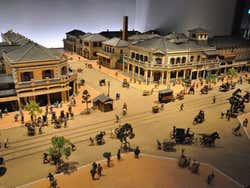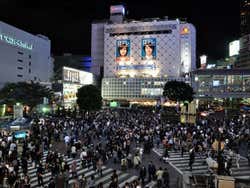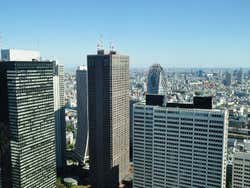
History of Tokyo
Traditionally the origins of Tokyo have been placed somewhere around the 12th century, but that was until some remains in Yayoy street were uncovered revealed that the area has been inhabited since the third century BC.
This third-century culture discovered has been called the "Yayoy street civilisation", and among the objects excavated were Chinese coins that show that the population of the time had a commercial relationship with the continent.
At the end of the 12th century, there also exists documentation confirming the existence of a fishing village called either Yedo or Edo (gate of the gulf, or land of the Ya), found on a low floodplain around the mouth of the Sumida river.
In 1457, a warrior known as Ota Dokuan, built a fortified area around which the marsh-dwelling population was concentrated.
From 1486 to 1524 the fort was occupied by a vassal of the Uesugi family and then by the Hozio Uzitsuma which unified the province and created a stat centred on the capital in Odawara.
In 1542, the first westerners, traders and missionaries arrived on the Tokyo coast, and the Japanese were accepting of the Christian religion and the firearms they brought.
Hideyoshi, who had been named shogun general by the emperor, decided to change his capital from Kyoto to Edo, and sent his son Yyeyasu to conquer the city.
The Edo period: The Tokugawa dynasty
In 1603, the Edo fortress and its surrounding region were conquered by Ieyasu Tokugawa. Ieyasu, a minor provincial aristocrat, unified Japan, subjugating the dissident feudal lords and giving his name to the dynasty which would govern the city and country over a century and a half, the period in which it was to reach the height of its splendour.
Ieyasu obliged the feudal lords, or "daimyos", as well as the samurais to make the new capital their residence, and that of their families, for at least six months of the year, making for a significant urban development, draining and restructuring the marshes and constructing canals which impulsed commerce in the city.
From that moment onwards it could be said that Japan had two capitals The growth of the new capital was striking, and in 1787 it already had more than 1.3 million inhabitants, despite the Great Fire of Edo in 1657, which killed around 100 thousand people.
The Tokugawa era was feudal and isolationist. In 1624 all foreigners were expelled from Japan and in 1633 it was prohibited for Japanese citizens to leave the archipelago on pain of death. In 1637 large capacity boats were prohibited so they could not enter deep waters, but this all opened the way for the Meiji Restoration.
With the feudal lords impoverished, the lower classes living in squalor and merchants and artisans fixing prices at will, the situation was untenable. And on the 9th of November 1867, the last Tokugawa shogun ceded power to the Meiji emperor.
The Meiji Restoration
In 1868 the country began to transform. Edo began to be the capital of the unified Meiji empire.
The emperor installed himself in the Edo fort, converting it into the Japanese Imperial Palace, and changed the name of Edo to Tokyo, meaning "Eastern Capital". He abolished all the feudal privileges which the lords had previously enjoyed, and opened up Japan to modernisation, both economic and administrative, with the aid of the samurai.
Earthquakes followed by major fires have marked the history of Tokyo, and in 1855 the city was destroyed by a raging fire, having to be reconstructed on the plain and delta of the Sumida river.
In 1872 yet another fire destroyed the districts of Ginza and Marunouchi, which were later rebuilt based on western architectural forms.
Tokyo in the 20th Century
At the beginning of the century, Tokyo became the centre of pan-Asian and nationalist movements and was a magnet for revolutionaries from neighbouring countries. It was, in fact, in Tokyo where the movement which would bring the downfall of the Manchu dynasty was born.
This tolerance was paid for by internal revolutionary action, coming to a head in 1918 with the Rice Riots, bringing about the collapse of the Terauchi Masatake administration, and ended in an increase of expansionist military power.
Throughout the First World War Japan fought on the side of the allied forces, with a view to the German possessions in China and the Pacific. In 1923 another earthquake destroyed almost half the city, and rebuilding Tokyo was expensive and lasted a full seven years, again following the latest in western architectural and city planning techniques.
Bombing activity during the Second World War, in which Japan fought on the side of the Axis powers, reduced Tokyo to rubble, causing over 80,000 deaths. Japan's surrender was later signed in the Tokyo bay, on board the famous USS Missouri. With the war over, from the 2nd September 1945, Tokyo was occupied and governed by the Allied Forces until April 1952.
With help from the United States, reconstruction following the war was swift and successful, and the '50s and '60s are known as the decades of the 'Japanese Miracle' - with Japan even taking on the mantle of the Olympic games in 1964.
Tokyo, growing in a manner unseen before, incorporated new neighbourhoods and even expanded into land reclaimed from the sea. Today it's become the world's most populated metropolis, its most advanced technological centre, and one of the most important financial centres in the world.


